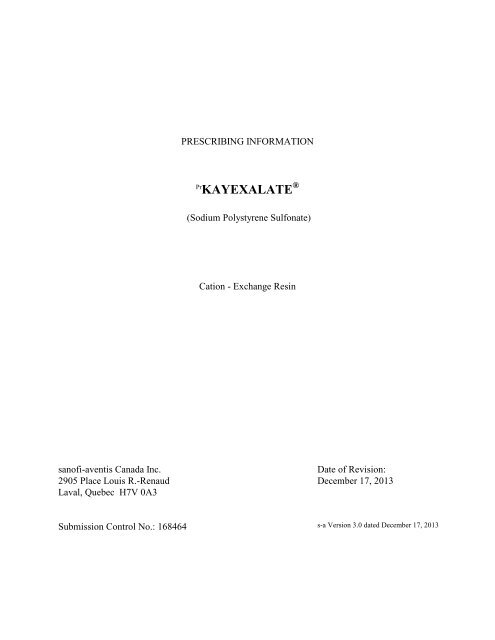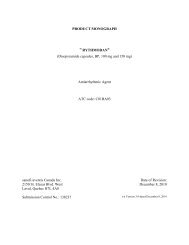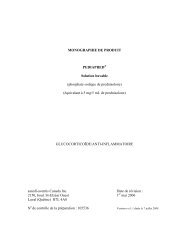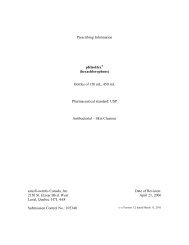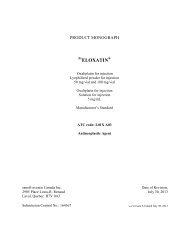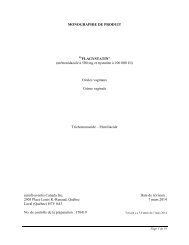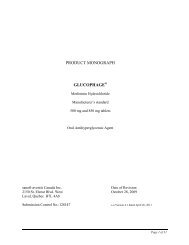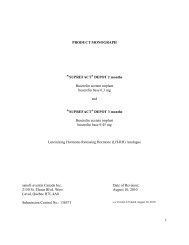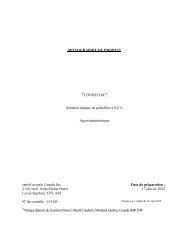Kayexalate (sodium polystyrene sulfate) - Sanofi Canada
Kayexalate (sodium polystyrene sulfate) - Sanofi Canada
Kayexalate (sodium polystyrene sulfate) - Sanofi Canada
- No tags were found...
Create successful ePaper yourself
Turn your PDF publications into a flip-book with our unique Google optimized e-Paper software.
PRESCRIBING INFORMATION<br />
Pr<br />
KAYEXALATE ®<br />
(Sodium Polystyrene Sulfonate)<br />
Cation - Exchange Resin<br />
sanofi-aventis <strong>Canada</strong> Inc.<br />
2905 Place Louis R.-Renaud<br />
Laval, Quebec H7V 0A3<br />
Date of Revision:<br />
December 17, 2013<br />
Submission Control No.: 168464 s-a Version 3.0 dated December 17, 2013
DESCRIPTION<br />
KAYEXALATE (<strong>sodium</strong> <strong>polystyrene</strong> sulfonate) is a light brown, to brown, finely ground<br />
powder of <strong>sodium</strong> <strong>polystyrene</strong> sulfonate. KAYEXALATE is a cation-exchange resin prepared in<br />
the <strong>sodium</strong> phase, with an in vivo exchange capacity of approximately 1 mmol (in vitro<br />
approximately 3.1 mmol) of potassium per gram. The <strong>sodium</strong> content is approximately 4.1 mmol<br />
(100 mg) per gram of the drug. KAYEXALATE can be administered either orally or as an<br />
enema.<br />
ACTION<br />
Sodium <strong>polystyrene</strong> sulfonate is not absorbed from the gastrointestinal tract. As the resin passes<br />
through the gastrointestinal tract, the resin removes the potassium ions by exchanging it for<br />
<strong>sodium</strong> ions. Most of this action occurs in the large intestine, which excretes potassium ions to a<br />
greater degree than does the small intestine. Potassium exchange also occurs in the colon<br />
following retention of the resin, when administered as an enema. The efficiency of this process is<br />
limited and unpredictable. It commonly approximates the order of 33 per cent but the range is so<br />
large that definite indices of electrolyte balance must be clearly monitored. Metabolic data are<br />
unavailable.<br />
INDICATION<br />
KAYEXALATE (<strong>sodium</strong> <strong>polystyrene</strong> sulfonate) is indicated for the treatment of hyperkalemia.<br />
CONTRAINDICATIONS<br />
KAYEXALATE (<strong>sodium</strong> <strong>polystyrene</strong> sulfonate) should not be administered to patients with the<br />
following conditions:<br />
• serum potassium
Concomitant administration of sorbitol is not recommended (see DRUG INTERACTIONS and<br />
ADVERSE REACTIONS).<br />
Alternative therapy in severe hyperkalemia: Since effective lowering of serum potassium with<br />
KAYEXALATE may take hours to days, treatment with this drug alone may be insufficient to<br />
rapidly correct severe hyperkalemia associated with states of rapid tissue breakdown (e.g. burns<br />
and renal failure). In such instances, some form of dialysis (peritoneal or hemo-) may be<br />
imperative.<br />
If hyperkalemia is so marked as to constitute a medical emergency (e.g. serum potassium above<br />
7.5 mmol/liter), immediate treatment with intravenous glucose and insulin, or intravenous<br />
<strong>sodium</strong> bicarbonate may be necessary as a temporary measure to lower serum potassium, while<br />
other long term potassium lowering therapy is initiated.<br />
Hypokalemia: KAYEXALATE therapy can precipitate serious potassium deficiency and the<br />
possibility of severe potassium depletion should be considered. It is therefore, imperative, to<br />
determine serum potassium levels at least daily and more frequently when indicated. Adequate<br />
clinical and biochemical control is essential during treatment especially in patients on digitalis.<br />
Therapy should be discontinued as soon as serum potassium falls below 5 mmol/L (see DRUG<br />
INTERACTIONS). Since intracellular potassium deficiency is not always reflected by serum<br />
potassium levels, the level at which treatment with KAYEXALATE should be discontinued must<br />
be determined individually for each patient. The patient's clinical condition and<br />
electrocardiogram are important in making this determination.<br />
Early clinical signs of severe hypokalemia include a pattern of irritability, confusion and delayed<br />
thought processes. Severe hypokalemia is often associated with a lengthened Q-T interval,<br />
widening, flattening or inversion of the T wave, and the appearance of U waves on the ECG.<br />
Cardiac arrhythmias such as premature atrial, nodal and ventricular contractions, and supraventricular<br />
and ventricular tachycardias may also occur. Marked hypokalemia can also be<br />
manifested by severe muscle weakness, at times extending into frank paralysis. The toxic effects<br />
of digitalis on the heart, especially various ventricular arrhythmia and A-V nodal dissociation, are<br />
likely to be exaggerated by hypokalemia. These effects can occur even though serum digoxin<br />
concentration is within the ‘normal range’.<br />
Patients at risk from an increase in <strong>sodium</strong> load: During the resin’s action in the intestinal<br />
tract, <strong>sodium</strong> is released mole for mole with potassium uptake. A single dose of KAYEXALATE<br />
(15 grams) contains approximately 60 mmol of <strong>sodium</strong>. Since the resin is a source of <strong>sodium</strong>,<br />
caution is advised when KAYEXALATE is administered to patients who cannot tolerate even a<br />
small increase in <strong>sodium</strong> loads and for whom an increase in <strong>sodium</strong> load may be detrimental (i.e.<br />
severe congestive heart failure, severe hypertension, marked edema or renal damage). In such<br />
instances compensatory restriction of <strong>sodium</strong> intake from other sources may be indicated and<br />
adequate clinical and biochemical control is essential. The calcium form of the resin may offer<br />
advantages in this situation.<br />
3
Other electrolytes disturbances: Like all cation-exchange resins, KAYEXALATE is not totally<br />
selective (for potassium) in its actions, and small amounts of other cations such as magnesium<br />
and calcium can also be lost during treatment. Patients receiving KAYEXALATE should be<br />
monitored for all applicable electrolyte disturbances.<br />
Other risks: In the event of clinically significant constipation, treatment with the resin should be<br />
discontinued until normal bowel motion is resumed. Magnesium-containing laxatives should not<br />
be used (see DRUG INTERACTIONS).<br />
The patient should be positioned carefully when ingesting the resin, in order to avoid aspiration,<br />
which could lead to bronchopulmonary complications.<br />
Children and neonates: In neonates, KAYEXALATE should not be given by the oral route. In<br />
both children and neonates, particular care should be observed with rectal administration.<br />
Excessive dosage or inadequate dilution could result in impaction of the resin.<br />
Due to the risk of gastrointestinal tract hemorrhage, colonic necrosis, or <strong>sodium</strong> overload,<br />
particular care should be observed in premature infants or low birth weight infants.<br />
DRUG INTERACTIONS:<br />
Concomitant use not recommended:<br />
Sorbitol (oral or rectal): Concomitant administration of sorbitol with KAYEXALATE is not<br />
recommended due to cases of intestinal necrosis, and other serious gastrointestinal<br />
adverse reactions, which may be fatal (see WARNINGS and ADVERSE REACTIONS).<br />
To be used with caution:<br />
Cation donating agents: may reduce the effectiveness of the resin in binding potassium.<br />
Aluminum hydroxide: intestinal obstruction due to concretions of aluminum hydroxide has<br />
been reported when aluminum hydroxide was combined with the resin.<br />
Digitalis drugs: the toxic effects of digitalis on the heart, especially various ventricular<br />
arrhythmias and A-V nodal dissociation, are likely to be exaggerated if hypokalemia is allowed<br />
to develop (see WARNINGS).<br />
Non-absorbable cation-donating antacids and laxatives: systemic alkalosis has been reported<br />
after cation-exchange resins were administered orally in combination with non-absorbable<br />
cation-donating antacids and laxatives such as magnesium hydroxide and aluminum carbonate.<br />
Lithium: possible decrease of lithium absorption.<br />
Thyroxine: possible decrease of thyroxine absorption.<br />
4
PREGNANCY:<br />
KAYEXALATE is not absorbed from the gastrointestinal tract. No data are available concerning<br />
the use of <strong>polystyrene</strong> sulfonate resins in humans during pregnancy.<br />
LACTATION:<br />
KAYEXALATE is not absorbed from the gastrointestinal tract. No data are available concerning<br />
the use of <strong>polystyrene</strong> sulfonate resins in humans during lactation.<br />
OVERDOSAGE<br />
Biochemical disturbances resulting from overdosage may give rise to clinical signs and<br />
symptoms of hypokalemia, including irritability, confusion, delayed thought processes, muscle<br />
weakness, hyporeflexia, and eventually frank paralysis. Apnea may be a serious consequence of<br />
the progression. Electrocardiographic changes may be consistent with hypokalemia; cardiac<br />
arrhythmia may occur. Hypocalcemic tetany may occur.<br />
Appropriate measures should be taken to correct serum electrolytes (potassium, calcium). The<br />
resin should be removed from the alimentary tract by appropriate use of laxatives or enemas.<br />
For management of a suspected drug overdose, contact your regional Poison Control Centre.<br />
ADVERSE REACTIONS<br />
Gastrointestinal disorders<br />
KAYEXALATE (<strong>sodium</strong> <strong>polystyrene</strong> sulfonate) may cause some degree of gastric irritation.<br />
Anorexia, nausea, vomiting and constipation may occur especially if high doses are given.<br />
Occasionally diarrhea develops.<br />
Large doses in elderly individuals may cause fecal impaction. These effects may be obviated<br />
through usage of the resin in enemas as described under "Dosage and Administration"'.<br />
Fecal impaction following rectal administration particularly in children and gastrointestinal<br />
concretions (bezoars) following oral administration have been reported. Gastrointestinal stenosis<br />
and intestinal obstruction have also been reported, possibly due to co-existing pathology or<br />
inadequate dilution of the resin. Intestinal obstruction due to concretions of aluminum hydroxide<br />
has been reported when aluminum hydroxide was used in combination with KAYEXALATE.<br />
5
Gastrointestinal ischemia, ischemic colitis, rectal haemorrhage, gastrointestinal tract ulceration or<br />
necrosis which could lead to intestinal perforation have been reported, which is sometimes fatal.<br />
The majority of cases have been reported with concomitant use of sorbitol (see WARNINGS and<br />
DRUG INTERACTIONS).<br />
Metabolism and nutrition disorders<br />
In accordance with its pharmacological actions, the resin may give rise to <strong>sodium</strong> retention,<br />
hypokalemia and hypocalcemia, and their related clinical manifestations (see WARNINGS and<br />
OVERDOSAGE). Cases of hypomagnesemia have been reported.<br />
Respiratory, thoracic and mediastinal disorders<br />
Some cases of acute bronchitis and/or bronchopneumonia associated with inhalation of particles<br />
of <strong>sodium</strong> <strong>polystyrene</strong> sulfonate have been described.<br />
DOSAGE AND ADMINISTRATION<br />
KAYEXALATE (<strong>sodium</strong> <strong>polystyrene</strong> sulfonate) is for oral or rectal administration only. The<br />
dosage recommendations given below are approximate. The precise requirements for each<br />
individual patient should be determined on the basis of regular clinical and biochemical<br />
assessments.<br />
Suspensions of KAYEXALATE should be freshly prepared and not stored beyond 24 hours.<br />
KAYEXALATE powder should not be heated as heating may alter the exchange properties of the<br />
resin.<br />
Adults, Including the Elderly:<br />
Oral:<br />
The average daily adult dose of the resin is 15 to 60 grams. This is provided by administering<br />
15 grams (approximately 4 level teaspoons) of KAYEXALATE one to four times daily. 1 gram<br />
of KAYEXALATE powder contains 4.1 mmol of <strong>sodium</strong>; one level teaspoon contains<br />
approximately 3.5 grams of KAYEXALATE powder and 15 mmol of <strong>sodium</strong>. A heaping<br />
teaspoon may contain as much as 10-12 grams of KAYEXALATE powder. Since the in vivo<br />
efficiency of <strong>sodium</strong>-potassium exchange resins is approximately 33 per cent, about one third of<br />
the resin's actual <strong>sodium</strong> content is being delivered to the body.<br />
Each dose should be given as a suspension in a small quantity of water or, for greater palatability,<br />
in syrup, but not in orange juice or other fruit juices that are known to contain potassium. The<br />
amount of fluid usually ranges from 20 to 100 mL, depending on the dose. It may be simply<br />
determined by allowing 3 to 4 mL per gram of resin.<br />
6
The resin may be introduced into the stomach through a plastic tube. If desired, it may be mixed<br />
with a diet appropriate for a patient in renal failure.<br />
Rectal:<br />
For adults, the resin may also be given, although with less effective results, in a daily enema.<br />
30 to 50 g of resin is given once or twice daily (at intervals of six hours). Each dose is<br />
administered as a warm emulsion (at body temperature) in 150 to 200 mL of aqueous vehicle<br />
(such as plain water, 10 per cent dextrose in water or equal parts of water and 2 per cent<br />
methylcellulose suspension). The emulsion should be agitated gently during administration. The<br />
enema should be retained for as long as possible and should be followed by a cleansing enema.<br />
After the initial cleansing enema, insert a soft, large size (French 28) rubber tube into the rectum<br />
for a distance of about 20 cm, with the tip well into the sigmoid colon. Then tape the tube in<br />
place. Suspend the resin in the appropriate amount of water or 10 percent dextrose in water at<br />
body temperature. While constantly stirring to keep the particles in suspension, introduce the<br />
suspension into the colon by gravitational flow. The suspension should be flushed with 50 or<br />
100 mL of saline solution, following which the tube is clamped and left in place. If back leakage<br />
occurs, the hips may be elevated on pillows or a temporary knee-chest position may be taken. A<br />
somewhat thicker suspension may be used, but care should be taken that no paste is formed.<br />
Paste formation has a greatly reduced exchange surface and is particularly ineffective, if<br />
deposited in the rectal ampulla. If possible, keep the suspension in the sigmoid colon for several<br />
hours. In order to remove the resin, irrigate the colon with non-<strong>sodium</strong> containing solution at<br />
body temperature. Two quarts of flushing solution may be necessary. The returns should be<br />
drained constantly through a Y tube connection. While the use of sorbitol is not recommended,<br />
particular attention should be paid to the cleansing enema whenever sorbitol has been used.<br />
It should be noted that the rectal route of administration should be reserved for patients who are<br />
vomiting or who have upper gastrointestinal tract problems, including paralytic ileus. The rectal<br />
route may also be used simultaneously with oral administration in cases where more rapid initial<br />
results are desirable. If both routes are used initially, it is probably unnecessary to continue rectal<br />
administration once the oral resin has reached the rectum.<br />
The intensity and duration of therapy depends upon the severity and resistance of hyperkalemia.<br />
Children:<br />
Oral:<br />
In smaller children and infants correspondingly lower doses should be employed. Calculation of<br />
the dose may be based upon the exchange rate of 1 mmol of potassium per g of resin. An<br />
appropriate initial dose is 1 g/kg body weight daily in divided doses in acute hyperkalemia. For<br />
maintenance therapy, dosage may be reduced to 0.5 g/kg body weight daily.<br />
Rectal:<br />
When refused by mouth, the resin may be given rectally using a dose at least as great as that<br />
which would have been given orally. The resin should be suspended in a proportional amount of<br />
7
10% dextrose in water. Following retention of the enema, the colon should be irrigated to ensure<br />
adequate removal of the resin (see WARNINGS).<br />
Neonates:<br />
Rectal:<br />
Since it is advised that the oral route should not be employed, only rectal administration should<br />
be considered. With rectal administration, the minimum effective dosage within the range of<br />
0.5 to 1 g/kg of resin should be employed. The resultant suspension should be diluted as for<br />
adults. Following administration of the resin, the colon should be adequately irrigated to ensure<br />
recovery of the resin (see WARNINGS).<br />
HOW SUPPLIED<br />
In white opaque HDPE jars of 454g.<br />
STORAGE<br />
Store at room temperature (15 to 30 °C).<br />
8


